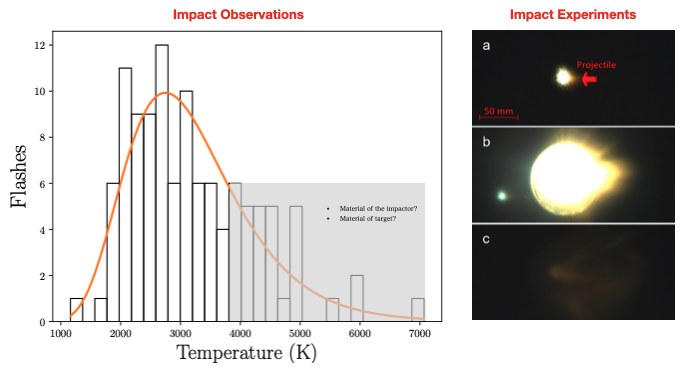1st live impact detection from Nice
The detection took place on the night of May 27th, 2020 at 20:48:49.420 UTC from OCA, Mt. Gros site. This is the first live impact observed for the project FLASH, the first from the Observatoire de la Côte d’Azur and the first in France. The telescope used was a MEADE ACF 40 cm equipped with a CMOS ASI ZWO 183 mono camera. The telescope was guiding on the lunar crescent using the lunar auto- guider that our team developed specifically for this project. The frame rate was 20 fps and the integration time was 0.05 s. The impact flash duration was 0.2 s and the small meteoroid originated from the background population and, therefore, we assume that it impacted the lunar surface with a speed of ~20 km/s.
1st impact crater discovery
At 18:56:10 UT on 2017-09-27, a meteoroid impacted the lunar surface. The impact was observed by SdR UAI Luna members Bruno Cantarella and Luigi Zanatta, using a dual telescope system capturing with ZWO ASI120MM cameras, running at 25 fps in one telescope, and 30 fps in the other. It was also confirmed to be observed by Stefano Sposetti in Gnosca, Switzerland, ruling out the possibility the flash being a false detection. The flash was detected in 29 frames in the 25 fps camera, giving it a duration of 1.12 s. Using the PyNAPPLE pipeline the produced crater was discovered in the NASA's Lunar Reconnaissance Orbiter images!

Size frequency distribution of small meteoroids
By combining all the available lunar impact flash detections of the last 20 years we constructed their size frequency distribution.
Temperatures of impact flashes: observations and laboratory experiments
Our team was the first that studied the temperatures of the lunar impact flashes, derived their distribution. We found that the peak of the distribution perfectly agrees with the theoretical average impact flash temperature. Moreover, the temperature range that has been observed so far also sutisfies the the theoretical predictions for the molten lunar regolith, while further investigation is on-going to study the excess tail of this distribution.
In order to study the temperature evolution of the impact flashes and go one step closer to the understanding of energy partitioning during an impact event, we have launced an experimental campaign of hypervelocity impacts. Our studies take palce at the Impact Lab of the University of Kent (UK), where using the 2-stage light-gas gun we fire small projectiles on the lunar regolith (simulant). With a custom-made device we record the impact flash evolution in different filters. This investigation is repeated using martian and asteroid simulants, as well their icy mixtures.





